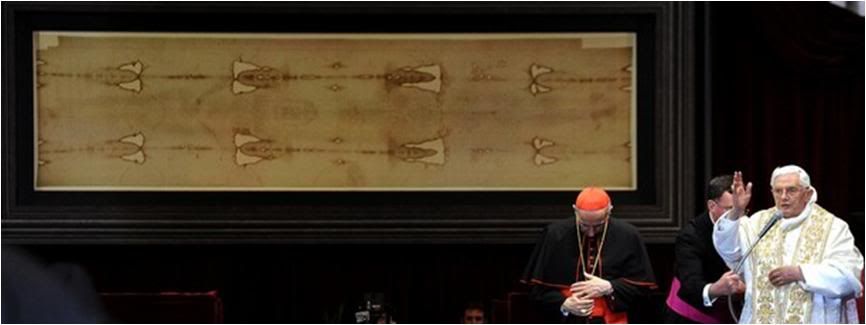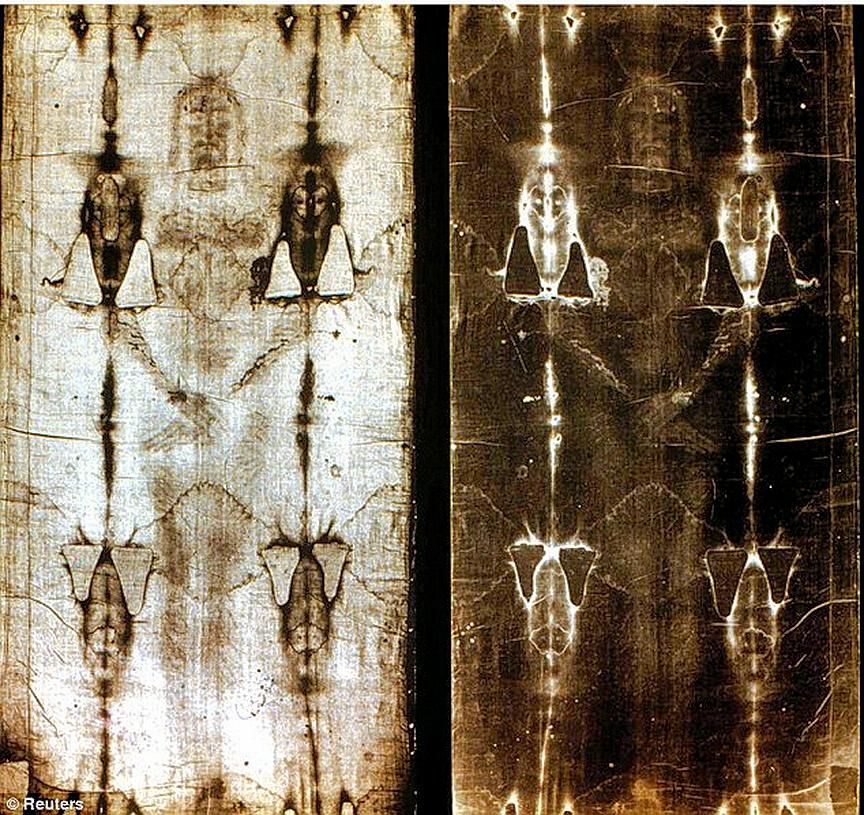| | | OFFLINE | | Post: 26.531
Post: 9.017 | Registrato il: 28/08/2005
Registrato il: 20/01/2009 | Administratore | Utente Master | |
|
 Holy Saturday, March 30
Holy Saturday, March 30
 Greek Orthodox icons: From left, Jesus is prepared for burial, with the Magdalene, the Virgin Mary, the Apostle John and Joseph of Arimathea; other icons show Jesus's descent to Hades.
Greek Orthodox icons: From left, Jesus is prepared for burial, with the Magdalene, the Virgin Mary, the Apostle John and Joseph of Arimathea; other icons show Jesus's descent to Hades.
Holy Saturday is celebrated with elaborate rituals in the Orthodox Church.
Let us return once more to the night of Holy Saturday. In the Creed we say about Christ’s journey that he “descended into hell.” What happened then?
Since we have no knowledge of the world of death, we can only imagine his triumph over death with the help of images which remain very inadequate.
Yet, inadequate as they are, they can help us to understand something of the mystery. The liturgy applies to Jesus’ descent into the night of death the words of Psalm 23[24]: “Lift up your heads, O gates; be lifted up, O ancient doors!”
The gates of death are closed, no one can return from there. There is no key for those iron doors. But Christ has the key. His Cross opens wide the gates of death, the stern doors. They are barred no longer. His Cross, his radical love, is the key that opens them. The love of the One who, though God, became man in order to die – this love has the power to open those doors. This love is stronger than death.
The Easter icons of the Oriental Church show how Christ enters the world of the dead. He is clothed with light, for God is light. “The night is bright as the day, the darkness is as light” (cf. Ps 138[139]12).
- Benedict XVI, Easter Vigil homily, 2007
Tonight the Holy Father presides at
EASTER VIGIL MASS
21:00 St. Peter's Basilica

 Of the days in the Paschal Triduum, Holy Saturday is usually the 'neglected' day. Benedict XVI has reflected a few times during his Pontificate on the significance fo Holy Saturday. Perhaps the most significant of this was his meditation upon visiting the Shroud of Turin in May 2010. Here is that reflection in full:
Of the days in the Paschal Triduum, Holy Saturday is usually the 'neglected' day. Benedict XVI has reflected a few times during his Pontificate on the significance fo Holy Saturday. Perhaps the most significant of this was his meditation upon visiting the Shroud of Turin in May 2010. Here is that reflection in full:

 The Shroud of Turin:
The Shroud of Turin:
Icon of Holy Saturday
by BENEDICT XVI
Meditation on his Visit to the Shroud
May 2, 2010
Dear friends,
This was, for me, a much-awaited moment. I have been before the Holy Shroud on other occasions, but this time, I am living this pilgrimage and this occasion with particular intensity.
Perhaps it is because the passage of years has made me even more sensitive to the message of this extraordinary icon. Perhaps - I would say, above all - it is because I am here this time as the Successor of Peter, and I carry in my heart the entire Church, and even all of mankind.
I thank the Lord for the gift of this pilgrimage, and for the opportunity to share with you a brief meditation, the theme of which was suggested to me by the subtitle of this solemn Exposition, namely, the mystery of Holy Saturday.
One can say that the Shroud is the icon for this mystery, the icon of Holy Saturday. Indeed it is a burial cloth which wrapped the remains of a man who was crucified, corresponding in every way to what the Gospels say of Jesus, who, having been crucified at noon, expired around three in the afternoon.
When evening came, since it was Parasceve, or the eve of the solemn Paschal Sabbath, Joseph of Arimathea, a rich and authoritative member of the Sanhedrin, courageously asked Pontius Pilate for permission to bury Jesus in a new tomb that he had ordered excavated not far from Golgotha.
Having obtained the permission, he bought a burial cloth, and after Jesus was taken down from the Cross, he wrapped him in that cloth and buried him in the sepulcher (cfr Mk 15,42-46). Thus says the Gospel of St. Mark, with whom the other evangelists concur.
Jesus remained in the tomb until the dawn of the day following the Sabbath, and the Shroud of Turin offers us the image of how his body lay in the tomb during that time - which was chronologically brief (about a day and a half), but immense, infinite, in its value and its significance.
Holy Saturday is the day when God was hidden, as one reads in an ancient homily: "What is happening? Today there is a great silence over the earth, a great silence, and stillness, a great silence because the King sleeps... God has died in the flesh, and the underworld has trembled" (Homily on Holy Saturday, PG 43, 439).
In the Credo, we profess that Jesus Christ was "crucified under Pontius Pilate, died and was buried; he descended into hell, and on the third day, he rose again from the dead".
Dear brothers and sisters, in our time, especially for those who have experienced the past century, mankind has become particularly sensible to the mystery of Holy Saturday. Hiding God is part of contemporary man's spirit, in an existential manner, almost unconscious, like a void in the heart that has grown increasingly larger.
Towards the end of the 19th century, Nietzsche wrote: "God is dead! And it is we who killed him". This famous statement, is clearly taken almost literally from the Christian tradition - we often say it in the Via Crucis, perhaps without fully realizing what we are saying.
After the two world wars, the lagers and the gulags, Hiroshima and Nagasaki, our age has become increasingly a Holy Saturday: the darkness of that day challenges all those who ask themselves about life, and it particularly challenges us believers. We too have something to do with this darkness.
Nonetheless the death of the Son of God, of Jesus of Nazareth, has an opposite aspect, totally positive, that is a source of comfort and of hope.
This makes me think of the fact that the Holy Shroud is like a 'photographic' document, with a 'negative' and a 'positive' image. Indeed, it is precisely that: the deepest myetery of the faith is at the same time the most luminous sign of unbounded hope.
Holy Saturday is a 'no man's land' between death and resurrection, but into this 'no man's land' entered someone, the Only One, who passed through it with the signs of his Passion for man: Passio Christi, passio hominis.
And the Shroud speaks to us precisely of this moment - it testifies precisely to that unique and unrepeatable interval in the history of mankind and the universe, in which God, in Jesus Christ, shared not just our dying, but also our remaining in death - it is the most radical solidarity.
In that 'time beyond time', Jesus Christ 'descended into hell'. What does this statement mean? It means that God, having made himself man, reached the point of entering man's extremest and absolute solitude, there where no ray of love enters, where total abandonment reigns without any word of comfort: the underworld.
Jesus Christ, remaining in death, went beyond the door of that ultimate solitude in order to lead even us to surpass it with him.
All of us have felt at some time the frightening sense of being abandoned, and what we most fear about death is precisely that, just as when we were children, we were afraid to be alone in the dark, and only the presence of a person who loved us could reassure us.
This is exactly what happened on Holy Saturday: the voice of God resounded in the kingdom of death. The unthinkable had occured, namely, that Love had penetrated into the bowels of Hell. Even in the extreme darkness of the most absolute human loneliness, we can hear a voice that calls us and find a hand that leads us out.
The human being lives for the fact that he is loved and he can love - and if, love has penetrated the space of death itself, then even there, life has arrived. In the hour of extreme solitude, we shall never be alone: Passio Christi, passio hominis.
This is the mystery of Holy Saturday. Precisely from the darkness of the death of the Son of God, has emerged the light of a new hope: the light of the Resurrection.
And it seems to me that, in looking at this sacred cloth with the eyes of faith, we can perceive something of that light. In effect, teh Shroud was immersed in that profound darkness, but it is at the same time luminous.
I think that if thousands upon thousands of people come to venerate it - without counting those who contemplate it in images - it is because they see in it not just darkness but also the light. Not so much the defeat of life and love, but rather victory, the victory of life over death, of love over hatred.
Yes, they see the death of Jesus, but they also see his Resurrection. In the bosom of death, life now pulses insofar as love is present.
This is the power of the Shroud: from the face of this 'man of sorrows', who carries on him the Passion of man in every time and in every place, even our passions, our sufferings, our difficulties, our sins.
“Passio Christi. Passio hominis”. From this face emanates a solemn majesty, a paradoxical lordship. This face, these hands, these feet, this chest, this whole body speaks - it is itself a word that we can hear in silence.
How does the Shroud speak? It speaks with blood, and blood is life! The Shroud is an Icon written in blood - the blood of a man who was flagellated, crowned with thorns, crucified and wounded on the left side.
The Image impressed on the Shroud is that of a dead man, but the blood speaks of his life. Every trace of blood speaks of love and life. Especially that abundant stain near his rib, made by the blood and water shed copiously from a major wound caused by the tip of a Roman lance.
That blood and water speak of life. It is like a spring that murmurs silently, and we can hear it, we can listen to it, in the silence of Holy Saturday.
Dear friends, let us always praise the Lord for his faithful and merciful love. When we leave this holy place, let us carry in our eyes the image of the Shroud, let us carry in our hearts this word of love, and let us praise God with a life full of faith, hope and charity. Thank you.



[Modificato da TERESA BENEDETTA 31/03/2013 03:34] |